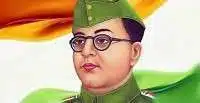
This passage can be considered as Netaji Subhash Chandra Bose biography including Subhash Chandra Bose date of birth as well as Subhash Chandra Bose date of death. Read this Subhash Chandra Bose essay to find Subhash Chandra Bose information and history. He was also called Netaji.
Netaji Subhash Chandra Bose
Subhash Chandra Bose fondly called as Netaji was one of the most prominent leaders of Indian freedom struggle. Born on 23 January 1897 in Cuttack, Orissa, he was the son of a famous lawyer Sh. Janaki Nath Bose. Subhash Chandra Bose was a brilliant student and greatly influenced by Swami Vivekananda’s teachings.
To fulfil his parents’ wishes, he went to England to compete for Indian Civil Services in 1919. In the year 1920, he passed the Civil Services exam with flying colours and stood fourth in order of merit. However, disturbed by the incident of Jallianwala Bagh, Netaji returned to India in 1921, leaving his administrative apprenticeship midway.
After returning to India, Netaji came into the influence of Mahatma Gandhi and joined the Indian National Congress. Soon, he moved his way up in the hierarchy of the party through his exemplary leadership qualities. Subhash with Jawahar Lal Nehru opposed the Dominican status and asserted complete independence for India. He even formed the Indian Independence League.
He was jailed in 1930 during the Civil Disobedience Movement and released in 1931 after the Gandhi Irwin Pact. He protested against the pact and opposed the suspension of Civil Disobedience Movement especially when Bhagat Singh and his associates were hanged.
Netaji was re-arrested under the infamous Bengal Regulation. After a year, he was released on medical grounds and banished from India to Europe. However, defying the ban, he returned to India and was again imprisoned for a year. In General Elections of 1937, Congress came to power in seven states and that led to the release of Netaji.
When the signs of World War II started appearing, he gave the British six months to free India failing which, there would be a revolt. There was much opposition to his rigid stand and he stepped down from his post of Congress President and formed a progressive group known as forwarding Block.
Later, Netaji led a mass movement against utilising Indian resources and men for the Second World War. There was a tremendous response to his call and he was put under house arrest. In 1941, Netaji left his home and reached Germany to seek the support of Germany and Japan against the British.
In 1942, he began his regular broadcasts from Radio Berlin which aroused strong enthusiasm in India. In 1943, he reached Singapore from Germany where he took over the reins of the Indian Independence Movement in East Asia from Ras Behari Bose and organised the Azad Hind Fauj or Indian National Army (INA).
The ‘Fauj’ proceeded towards India to liberate her from the British rule. Enroute, it liberated Andaman and Nicobar Islands. Azad Hind Fauj crossed the Burma Border and stood on Indian soil on 8 March 1944. However, the defeat of Japan and Germany compelled the INA to retreat. Netaji was reportedly killed in a plane crash near Taiwan in 1945.
Though, it was widely believed that he was still alive post the plane crash, however, no information could be gathered about him. Thus, Netaji’s contribution towards India’s independence is no less than that of JL Nehru or Bhagat Singh, however, it remains lesser known to people. The Indian education system must make efforts to remind people of the forgotten hero.